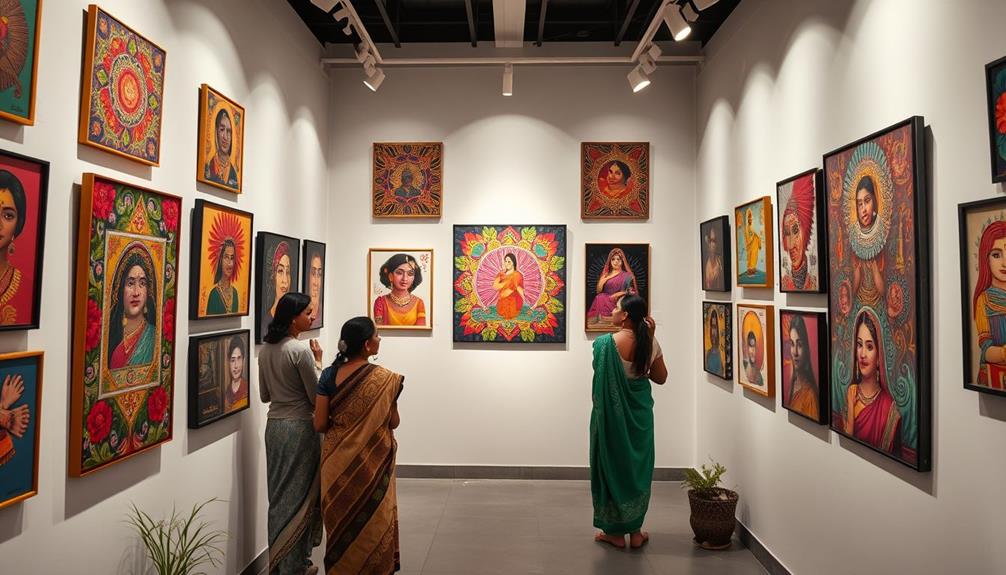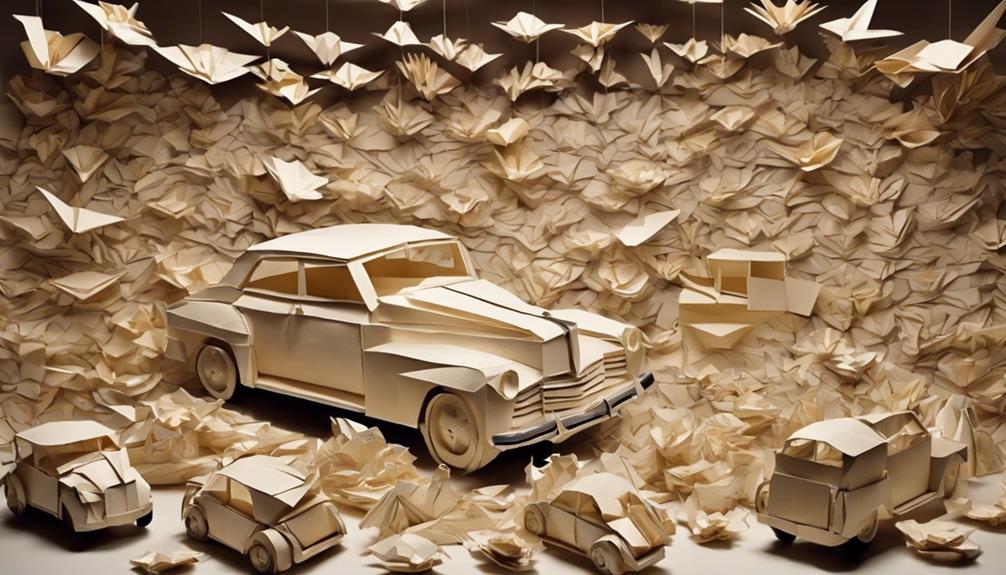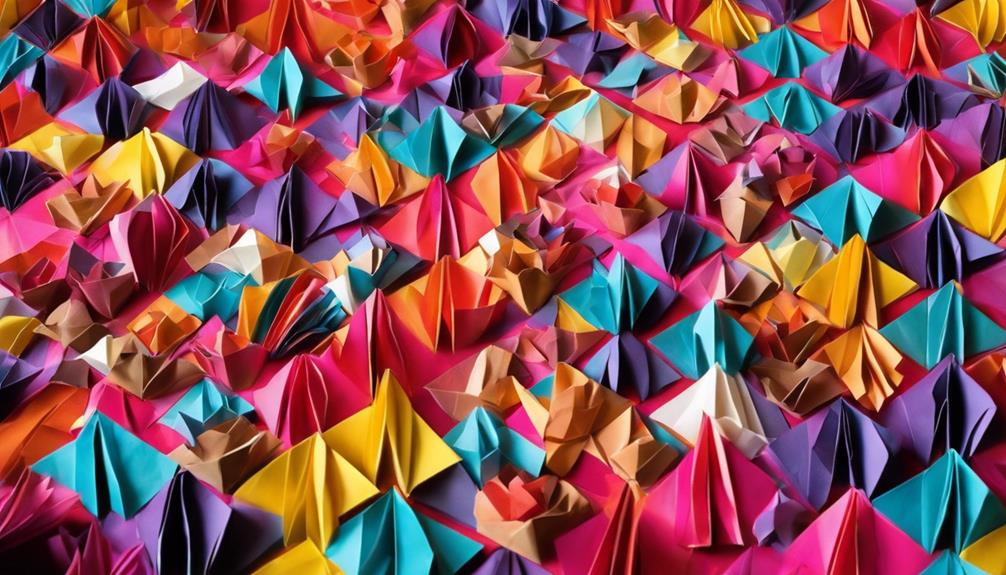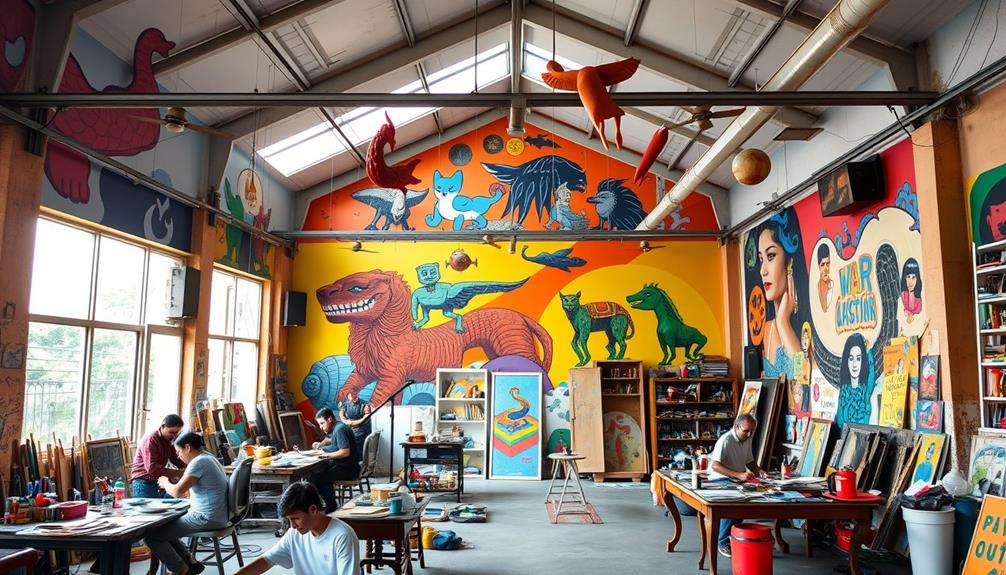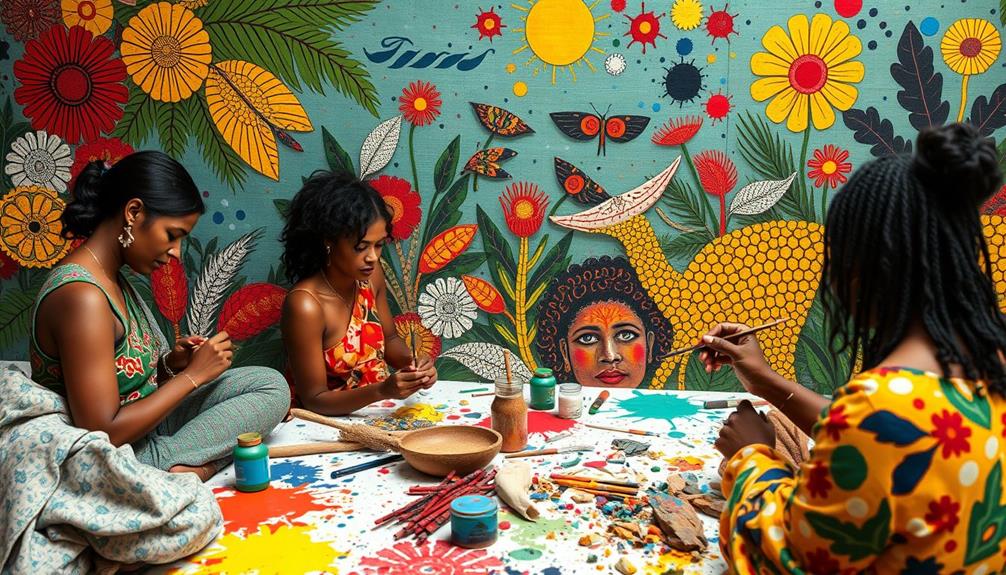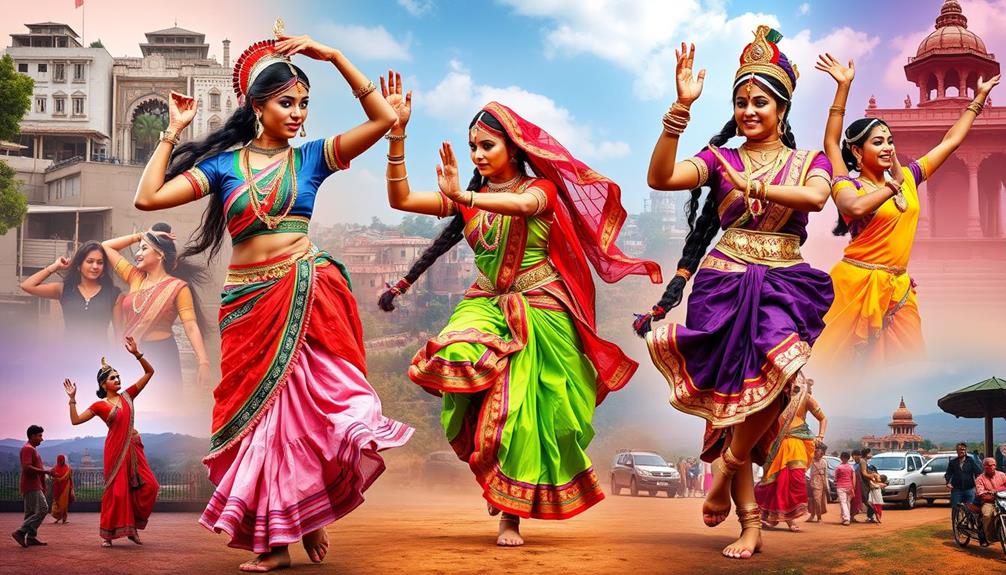Art was essential to India's freedom movement, acting as a powerful way for you to express solidarity against colonial rule. Visuals of leaders like Gandhi and the vibrant prints from artists inspired national pride and mobilized the masses. Techniques like printmaking brought sentiments of resistance to the public eye, creating a collective identity. Cinema also played a significant role, shaping narratives and highlighting lesser-known heroes. Through poetry, theater, and various art forms, you can see how creativity fueled the struggle for independence. There's much more to uncover about this impactful journey and how art intertwined with activism.
Key Takeaways
- Art served as a powerful medium for expressing nationalist sentiments and fostering a collective identity during India's struggle for independence.
- Printmaking, particularly in Kanpur, played a crucial role in disseminating revolutionary ideas and mobilizing public sentiment against colonial rule.
- Cinema reshaped narratives of the freedom movement, highlighting both well-known and lesser-known heroes, influencing contemporary perceptions of India's history.
- Notable artists like Rabindranath Tagore and Nandalal Bose used their works to unite people and promote cultural identity in the fight for freedom.
- Various artistic forms, including literature and theater, critiqued colonialism and inspired engagement, galvanizing support for the independence movement across the nation.
Historical Context of Independence
The Indian independence movement, fueled by a complex interplay of social, political, and economic factors, began to gain momentum in the late 19th century. The formation of the Indian National Congress in 1885 marked a pivotal moment, providing a platform for political activism aimed at achieving freedom from colonial rule.
As you investigate this historical context, you'll notice how figures like Mahatma Gandhi emerged, advocating for non-violent resistance and symbolizing Indian nationalism. The desire for independence resonated deeply within the cultural fabric of India, inspiring artists to create works that not only reflected societal challenges but also showcased the rich heritage of the nation through sustainable home decor and traditional craftsmanship.
Indian art played a significant role in this narrative, reflecting the aspirations and struggles of diverse communities involved in the freedom struggle. Artists used their work to express dissatisfaction with colonial rule and to celebrate the heroes of the movement.
As you explore this evolution, consider how contemporary representations in art and cinema, including films like "RRR," shift focus from well-known leaders like Gandhi and Nehru to figures like Subhas Bose and Bhagat Singh. This evolution illustrates that the narrative surrounding the Indian independence movement is complex, and the historical context continues to shape how freedom is represented in Indian art today.
Influence of Cinema on Narratives

Cinema plays an essential role in shaping how you view India's freedom struggle, often shifting focus from traditional leaders like Gandhi to revolutionary figures such as Subhas Bose and Bhagat Singh.
As you watch films like "RRR," you might notice how they not only entertain but also comment on contemporary political sentiments. This evolving portrayal can reshape public memory and influence your understanding of historical narratives.
Moreover, the influence of storytelling in films can evoke emotional connections similar to those found in impactful speeches by influential orators.
This dual power of cinema and rhetoric can deepen your engagement with historical events and their relevance today.
Changing Historical Perspectives
Shaping historical narratives through film has become a powerful tool in contemporary India, as seen in works like "RRR." This film shifts focus from traditional icons like Gandhi and Nehru to figures such as Subhas Bose and Bhagat Singh, challenging established views of the freedom struggle. By highlighting these lesser-known heroes, it invites you to reconsider who truly represents the fight against colonial rule.
Additionally, this cinematic approach can be likened to how vegan food options are increasingly becoming mainstream, reflecting a shift in cultural narratives.
Screenwriter Vijayendra Prasad's approach demonstrates how cinema can reshape public perceptions of key historical figures. As you watch "RRR," you might notice that while it's visually stunning, it often sacrifices historical accuracy for dramatic effect. This trend reflects a broader pattern in contemporary cinema, where artistic representation sometimes diverges from factual history.
Moreover, social media amplifies this shift, allowing audiences to engage in discussions that reflect diverse interpretations of the freedom movement. As you explore these narratives, consider how they resonate with current political sensibilities in India.
Ultimately, films like "RRR" serve not just as entertainment but as cultural artifacts that influence how you understand and relate to India's past and its ongoing journey toward freedom and identity.
Cinema as Political Commentary
Artistic expression in film offers a unique lens through which you can examine political narratives and historical interpretations. Cinema serves as a powerful medium for political commentary, shaping how you perceive the freedom struggle and its key figures.
Take the film "RRR," for instance. It redefines narratives by focusing on leaders like Subhas Bose and Bhagat Singh, pushing traditional icons like Gandhi and Nehru to the background. This shift reflects current political sensibilities and invites you to question established historical accounts. The psychological impact of such cinematic portrayals can influence the self-perception of audiences, altering how they view their own connection to India's past.
Screenwriter Vijayendra Prasad's work exemplifies this trend, merging entertainment with a reimagined understanding of India's independence movement. Social media further amplifies this influence, allowing cinematic portrayals to shape public perceptions of historical events and figures.
However, while "RRR" dazzles with its visual spectacle, it has been criticized for lacking depth in historical accuracy, highlighting the tension between artistic portrayal and factual representation.
Ultimately, the portrayal of freedom fighters in cinema not only entertains but also acts as a conduit for political commentary, influencing contemporary discussions around India's freedom struggle. This intersection of art and politics underscores cinema's crucial role in narrating your history.
Artistic Responses to the Struggle

Creativity flourished as artists responded to the Indian freedom struggle, using their work to reflect the national aspirations of the time. Indian artists harnessed their talents to evoke national pride, addressing colonial atrocities through powerful imagery and themes.
This artistic renaissance not only fostered a sense of unity but also showcased diverse expressions, much like how stain art challenges traditional notions of beauty. They transformed art into a tool for resistance and inspiration.
Here are three ways artistic responses shaped the struggle:
- Depictions of Leaders: Figures like Mahatma Gandhi became symbols of hope, with artists capturing his spirit to rally the masses and inspire action against British rule.
- Cultural Revival: The Bengal School of Art, led by Abanindranath Tagore, focused on indigenous styles, promoting a sense of identity that countered Western influences. This helped foster a collective consciousness rooted in India's rich cultural heritage.
- Social Commentary: Nationalist art replaced traditional religious themes with depictions of the fight against oppression, effectively communicating the urgency of social issues and mobilizing public sentiment against colonial rule.
Through these artistic responses, the struggle for freedom transformed into a vibrant expression of identity and resistance, uniting people in a shared vision for a liberated India.
Printmaking in Nationalist Art

In understanding the role of printmaking in nationalist art, you'll find that it played an essential part in shaping India's freedom movement. Key printmakers like Shyam Sundar Lal used innovative techniques to create works that stirred national sentiment and inspired action.
Butter, much like printmaking, has a rich history and versatility that can enhance various cultural practices; for instance, butter enhances flavors in dishes, reflecting the importance of local ingredients in art and cuisine.
The historical significance of these prints extends beyond art; they reflect a powerful intersection of politics, spirituality, and community engagement during a pivotal time in India's fight for independence.
Historical Significance of Printmaking
How did printmaking become a powerful tool in India's freedom movement?
Printmaking emerged as a significant medium for expressing nationalist sentiments, particularly in places like Kanpur, where workshops produced influential prints. These works engaged the Indian people, making the movement's messages accessible and resonating with their aspirations.
Additionally, much like the diversification of retirement portfolios, printmaking allowed for a variety of artistic expressions that could reach different segments of society. The visual language created through these prints fostered public awareness about the freedom struggle.
Here are three reasons why printmaking was historically significant:
- Widespread Reach: Artists used prints to disseminate ideas, creating a visual language that reached a broad audience, fostering public awareness about the freedom struggle.
- Cultural Connection: Prints often featured figures like Mahatma Gandhi, linking contemporary struggles to historical and spiritual narratives, which helped unite diverse groups under a common cause.
- Political Commentary: Artists like Prabhu Dayal created works that intertwined art, politics, and spirituality, reflecting the complexity of the nationalist movement and inspiring action among the populace.
Through these elements, printmaking became not just an art form, but a pivotal tool in shaping the consciousness of Indian people during the fight for independence.
Key Printmakers and Techniques
During the late 19th and early 20th centuries, key printmakers played a crucial role in shaping nationalist art in India. Kanpur emerged as a significant center for this movement, with influential workshops producing works that captured nationalist sentiments. Shyam Sundar Lal's workshop became pivotal in creating prints that depicted prominent leaders and critical events in the freedom struggle.
The emotional dependence fostered by such art can be compared to the dynamics in narcissistic relationships, where the need for validation often overshadows genuine connection.
These prints served as accessible mediums, effectively conveying nationalist ideas to the general populace, despite limited data on how they were distributed. Among the talented artists was Prabhu Dayal, who worked closely with Sundar Lal. His impactful artwork, like "Satyagraha Yoga-Sadhana," featured Gandhi alongside key political figures, further emphasizing the connection between art and activism.
Printmakers often drew parallels with historical and mythological themes, blending art, spirituality, and political aspirations. By employing various techniques, they not only illustrated the struggle for independence but also inspired a collective consciousness among the masses.
This fusion of art and activism became a powerful tool in the quest for freedom, ensuring that nationalist sentiments were vividly portrayed through printmaking during this transformative period in Indian history.
Impact on National Sentiment
While the prints created in Kanpur captured the spirit of the nationalist movement, their true impact on national sentiment was profound. These artworks not only represented the aspirations of the Indian people but also played an important role in uniting diverse communities against colonial rule. Here's how they shaped national sentiment:
- Visual Representation: Prints often featured Mahatma Gandhi and other leaders, creating a collective identity that resonated deeply with the public. This visual connection to leaders helped to reinforce the significance of personal growth in the movement, as individuals began to see their own journeys reflected in these iconic figures.
- Mobilization of Emotion: The combination of political and spiritual themes in these prints stirred emotions, encouraging people to engage actively in the fight for independence. The emotional resonance of these works can be likened to the bonding experiences found in team-based games, where shared feelings bolster community ties.
- Cultural Unity: By disseminating nationalist ideas, printmakers fostered a sense of belonging among different Indian communities, reinforcing shared goals and aspirations.
Despite the challenges in understanding the full extent of their distribution, surviving prints reveal valuable perspectives on the struggle for independence. They demonstrate how art transcended mere aesthetics, transforming into a powerful medium that influenced public sentiment and inspired collective action.
In this way, Kanpur's printmakers greatly shaped the narrative of India's freedom movement.
Notable Artists and Their Impact

Drawing inspiration from their cultural heritage, notable artists played a pivotal role in India's freedom movement by using their creative talents to ignite a sense of nationalism.
Rabindranath Tagore, the first non-European Nobel laureate, crafted poetry and plays that united Indians, fostering a collective spirit during the struggle. His works resonated with the common people, encouraging them to rise against colonial rule.
The emphasis on natural materials in contemporary design reflects the desire for authenticity, much like the artists' quest for genuine expression in their work.
Abanindranath Tagore markedly influenced the revival of Indian art, blending traditional styles with contemporary themes, which served as symbols of resistance. His contributions inspired others, as artists like Nandalal Bose embraced indigenous aesthetics, highlighting national identity through their creations.
Jamini Roy, known for merging folk art with modern techniques, celebrated Indian culture, creating pieces that resonated deeply during the nationalist movement.
Additionally, artists like Chittoprasad and Henri Cartier-Bresson critiqued British colonialism through visual arts, effectively shaping public sentiment and raising awareness about the struggles faced by the common people.
Through their passionate expressions, these artists not only preserved India's rich heritage but also ignited a fervor for freedom that would echo throughout the country.
Art as Political Expression

Art served as a powerful vehicle for political expression in India's freedom movement, with artists and writers using their talents to evoke a sense of nationalism and resistance. Through various forms like painting, literature, and theatre, they stirred the hearts of the people, igniting a passion for independence.
Key elements of this artistic revolution include:
- National Imagery: Artists depicted Bharat Mata as a symbol of freedom, inspiring people to unite under a common cause.
- Literary Works: Writers like Rabindranath Tagore infused their narratives with patriotic fervor, using songs like "Vande Mataram" to rally support and foster a national identity.
- Theatrical Expression: Playwrights showcased the struggles against colonial rule, using drama to critique oppressive policies while engaging audiences in meaningful discussions about their rights.
These art forms weren't just creative outlets; they were crucial instruments for change, galvanizing the masses to take action against British rule.
Frequently Asked Questions
What Was the Role of Indian Artists Toward the Freedom Movement?
Indian artists inspired you through their powerful works, using national themes to evoke patriotism. They created art that communicated struggles, educated audiences, and fostered pride in heritage, rallying support for independence and self-sufficiency.
How Did the Indian Painters and Sculptors Contribute to the Indian National Freedom Movement?
Like a vibrant tapestry, Indian painters and sculptors wove nationalism into their art. You see how they echoed indigenous styles, inspiring pride and unity, while challenging colonial narratives through powerful imagery that stirred the hearts of the people.
Why Is Art Important in Indian Society?
Art's important in Indian society because it reflects cultural identity, sparks emotions, and fosters community. You'll find that it inspires creativity, encourages dialogue, and preserves traditions, shaping a vibrant and unified social landscape.
What Was the Role of Literature in the Freedom Movement of India?
You see, literature stirred passion, igniting hearts across India. Poets and writers crafted words that united communities, inspired actions, and fueled a collective desire for freedom, making them powerful tools in the fight against colonial oppression.
Conclusion
In the tapestry of India's freedom movement, art wove threads of hope and resistance, shaping a nation's identity. Just as a phoenix rises from ashes, artists transformed pain into powerful symbols of courage and unity. Their vibrant brushstrokes and evocative films ignited passions, fueling the flames of rebellion. As you reflect on this rich legacy, remember: art isn't just for appreciation; it's a living force that continues to inspire and provoke change in our world today.

